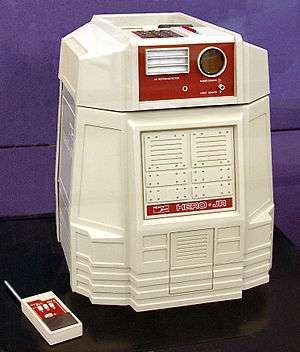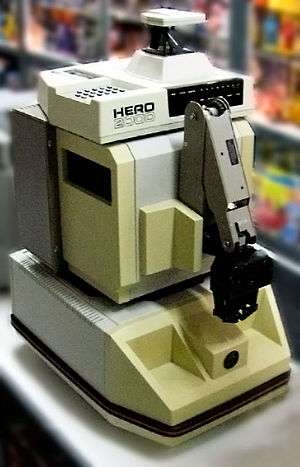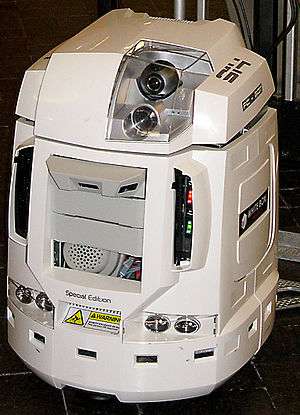HERO (robot)
HERO (Heathkit Educational RObot) is a series of several educational robots sold by Heathkit during the 1980s. The Heath Company began the HERO 1 project in October 1979, with the first release in 1982.[1] Models include the HERO 1, HERO Jr., and HERO 2000. Heathkit supported the HERO robot line until 1995. All three were produced as kits, or for more money, prebuilt by Heathkit. The 1980s models are considered collectors items, due to their rarity.[2] For the most part, they cannot perform practical tasks, but are more geared toward entertainment and education above all.
HERO 1 (ET-18)
 HERO 1 | |
| Manufacturer | Heathkit |
|---|---|
| Type | robot |
| Release date | 1982 |
| Introductory price | Kit 1500 US$ (equivalent to $3,973.97 in 2019), Assembled US$2,500 (equivalent to $6,623.28 in 2019)[3] |
| Discontinued | 1995 |
| Units sold | 14,000 (across 8 years) |
| Media | Assembly manual, user's manual, technical manual, and speech dictionary |
| CPU | Motorola 6808 |
| Memory | RAM: 4 kB Monitor ROM: 2 kB |
| Storage | Compact Cassette |
| Display | six 7-segment LEDs |
| Sound | Votrax SC-01 speech synthesizer[4][5] (Included with Assembled version and $149.95 option for kit) |
| Input | Hex keypad with 17 keys |
| Power | Batteries: four 6-volt gel cell Charger: 120/240 VAC, 50/60 Hz charger |
| Dimensions | 20 inches high x 18 inches wide (50 cm x 45 cm) |
| Mass | 39 pounds (18 kg) |
HERO 1 is a self-contained mobile robot controlled by an onboard computer with a Motorola 6808 CPU and 4 kB of RAM. The robot features light, sound, and motion detectors as well as a sonar ranging sensor. An optional arm mechanism and speech synthesizer was produced for the kit form and included in the assembled form.[6][7]
To make this power available in a simple way, high-level programming languages were created. For example, the ANDROTEXT language is a HERO 1 editor and compiler developed in 1982 for the IBM PC.[8][9][10][11]
HERO 1 is featured on a few episodes of the children's television program Mr. Wizard's World.[12][13] Byte magazine called HERO 1 "a product of extraordinary flexibility and function ... If you are interested in robotics, Heath will show you the way".[14]

HERO Jr. (RT-1)
 Hero Jr. (with optional remote control) | |
| Manufacturer | Heathkit |
|---|---|
| Type | robot |
| Release date | 1984 |
| Introductory price | Kit US$599.95, Assembled US$1000[3] |
| Discontinued | Before October 1987 (Assembled)[15] 1995 (Kit) |
| Units sold | 4000 (across 8 years) |
| CPU | Motorola 6808 1 MHz |
| Memory | RAM: 2 kB, expandable to 24 kB Monitor ROM: 32 kB |
| Display | 9 LEDs |
| Sound | Votrax SC-01 speech synthesizer[5] |
| Input | Hex keypad with 17 keys |
| Power | Batteries:6 V 3.8 A·h x2, x4 optional |
| Dimensions | 19 inches high[16] |
| Mass | 21.5 pounds[16] |
A smaller version called HERO Jr. was released later. Heathkit intended it for the home market, and therefore made it less complex, and more self-contained. Like HERO 1, HERO Jr. has a 6808 processor, but only 2 kB of RAM. It has onboard speech synthesis, a Polaroid sonar range sensor, a light sensor, a sound sensor, and an optional infrared sensor. Other optional components include a pair of extra batteries to double the operational time between charges, from an estimated 4 hours to 8 hours. A remote control accessory allows users to drive the robot around. It includes a motion sensor that causes the robot to croak "SOM-THING-MOVE" when it detects a source of motion.
Heathkit released several add-ons to increase the robot's capabilities, including a transmitter to activate a home security system in the event it senses movement while on "guard duty". Also, additional cartridges with programs and games were produced, as well as a components to allow the user to directly program the robot.
The drive mechanism is backward compared to the HERO 1, with the drive and steering wheel in the back of the robot. The head section features an indentation to allow the robot to transport up to 10 pounds (4.5 kg). The robot can speak several phrases from various films that involve robots or computers. It is capable of remembering and repeating back its master's name, singing songs, reciting poems, acting as an alarm clock, and making its own combinations of phonemes to create a robotic gibberish.
HERO 2000 (ET-19)
 HERO 2000 | |
| Manufacturer | Heathkit |
|---|---|
| Type | robot |
| Release date | 1986 |
| Introductory price | Kit US$3,000 Assembled US$4,500[17] |
| Discontinued | 1995 |
| Units sold | 3000 (across 8 years) |
| CPU | Intel 8088 (Main) 6 slave Z-80 processors (11 with optional arm) |
| Memory | RAM: 24 kB, expandable to 576 kB, Monitor ROM: 64 kB with integrated BASIC |
| Display | 16 head-mounted LED status indicators (eight are user definable) RS-232 serial port |
| Sound | Silicon Systems SSI 263 (analog formant) speech synthesizer[18] |
| Input | hexadecimal keypad RS-232 serial port |
| Power | Battery: single 24 amp-hour battery, Charger: 120 VAC charger included |
| Dimensions | Height 32 inches (81 cm)[19] |
| Mass | 78 pounds (35 kg)[19] |
The much more powerful HERO 2000 includes several onboard microprocessors, onboard speech synthesis, several sensors, and the ability to add expansion cards using a passive backplane.[20]
HE-RObot
 HE-RObot is a badge-engineered version of the 914 PC-Bot (pictured) by White Box Robotics. | |
| Developer | White Box Robotics[21] |
|---|---|
| Manufacturer | Heathkit |
| Type | robot |
| Release date | 2007 |
| Introductory price | up to US$8,000 |
| Discontinued | 2012 |
| Units sold | approximately 50 |
| Operating system | Windows XP Pro |
| CPU | Intel Core Duo |
| Memory | 1 GB DDR2 RAM |
| Storage | 80 GB 2½ in. SATA Hard drive |
| Power | Batteries: 2 x 12V 9Ah Lead Acid Battery Charger: SONEIL 12V Intelligent Battery Charger (3A) |
| Dimensions | Height 21 inches (53 cm) |
| Mass | 25 kg (55 lb) |
| Website | www |
The HE-RObot is the result of a strategic partnership between Heathkit and White Box Robotics, marketed to the educational market. When available, it cost up to US$8,000. Heathkit sold approximately 50 of these robots before bankruptcy in 2012.[22][23][24]
See also
- Topo, a programmable robot series for home computers in 1983-1984
- R.O.B., a 1985 video game playing toy robot accessory for the Nintendo Entertainment System
- Short Circuit, the 1986 sci-fi film starring the robot Johnny Five
- Transformers
- 1980s in science and technology
References
- Whatever Happened To Heathkit?, By Lou Frenzel, Electronic Design, Feb 18, 2009
- Classic Heathkit Electronic Test Equipment, By Jeff Tranter, 2013, Page 12. Some interesting Heathkit facts and trivia: * Heathkit offered one of the first consumer robot kits, the HERO 1. Introduced in 1982, it featured a 6808 microprocessor with four kilobytes of memory and sensors for light, sound and motion. Programs could be stored on cassette tape and a speech synthesizer and robotic arm were available as options. It is now a sought after collector's item. ISBN 0992138205
- Tech Watch, By Cynthia McClean, Page 78, Black Enterprise, Jun 1985, Hero 1 - Kit US$1150 / Assembled US$2149; Hero Jr - Kit US$599.95 / Assembled US$1000
- HERO walks, talks, educates and protects, By David Needle, Page 1 & 4, InfoWorld, 27 Dec 1982, With the aid of its Votrax speech chip...
- Hero Robot Frequently Asked Questions, Donnie V. Savage Site
- Mark J. Robillard: HERO 1 - Advanced Programming and Interfacing, H.W. Sams 1983. ISBN 0-672-22165-9
- Howard Boyet: Hero 1 - Advanced Programming Experiments, Heathkit/Zenith 1984. ISBN 0-87119-036-2
- ACM (1982). "ANDROTEXT for HERO 1 Editor and Compiler IBM PC". Online Historical Encyclopaedia of Programming Languages, ACM History of Programming Language Conference (HOPL).
- Solem, J. C. (1984). "ANDROTEXT-A high-level language for personal robots". Robotics Age magazine. 6: 16.
- Fuller, James (1988). ROBOTICS: Introduction, Programming, and Projects. Prentice-Hall.
- Gupta, A. K.; Arora, S. K. (2009). "Industrial Automation and Robotics". (Laxmi Publications): 379.
- Building A Robot: The Crash Course, By William J. Broad, Published: May 3, 1983, The New York Times
- Robots: Best Educational Platform Ever, Apr 25, 2013 by Lou Frenzel, Communiqué
- Leininger, Steve. "Heath's HERO-1 Robot". BYTE. p. 86. Retrieved 19 October 2013. volume 8 number, 1 January 1983
- HERO Jr, DAMARK International Advert, Page 136, Popular Mechanics, Oct 1987 - Public notice: Heath no longer make factory assembled model. They decided to produce the kit version. So we brought the remaining inventory..., Manufactures recommended price US$1078.85 DAMARK PRICE: US$298
- Robot helps at home, Page 25, Pittsburgh Post-Gazette, Oct 9, 1984
- Electronics Newsfront, By William J. Hawkins, Page 28, Popular Science, Feb 1986
- I believe you are referring to the SSI 263 from Silicon Systems. Steve Ciarcia had a Circuit Cellar article based on it and the Hero 2000 used it for speech. .., Subject:speech chips, Post by Alan Matthew, 23 Nov 1996 04:00:00
- Professor Robot, Page 13, The Rotarian, Jun 1986
- John D. Hubbard, Lawrence P. Larsen: Hero 2000 - Programming and Interfacing, Heathkit/Zenith 1986. ISBN 0-87119-153-9
- Leading educational systems company, and the Grandfather of the Hero Robot, to standardize on White Box Robotics PC-BOT technology, BENTON HARBOR, MI, and OTTAWA, CANADA December 12, 2007 White Box Robotics Inc., the leader in PC based general service robots, and Heathkit Company Inc., the leader in Educational Systems, today announced a multi-year strategic agreement under which Heathkit will deploy the White Box Robotics PC-BOT to its clients. As part of the agreement, Heathkit will produce, manufacture and distribute an educational version of the robot to be known as the HE-RObot. More to come shortly..., December 12, 2007, News & Events, White Box Robotics
- HE-RObot: The Next Generation of Heathkit HERO Robots Posted by james on December 26, 2007 at 03:16 PM in Do-It-Yourself, Robots - Retro Thing
- "Archived copy". Archived from the original on January 26, 2013. Retrieved March 6, 2015.CS1 maint: archived copy as title (link)
- 914 PC Bots Community Archived 2015-04-02 at the Wayback Machine, Forum
Bibliography
- Howard Boyet: Heath's robot "HERO": 68 experiments : fundamentals and applications, Microprocessor Training 1983. ISBN 9994699709
- Mark J. Robillard: HERO 1 - Advanced Programming and Interfacing, H.W. Sams 1983. ISBN 0-672-22165-9
- Howard Boyet: Hero 1 - Advanced Programming Experiments, Heathkit/Zenith 1984. ISBN 0-87119-036-2
- John D. Hubbard, Lawrence P. Larsen: Hero 2000 - Programming and Interfacing, Heathkit/Zenith 1986. ISBN 0-87119-153-9